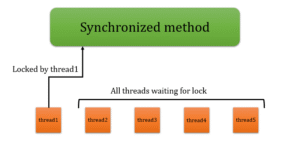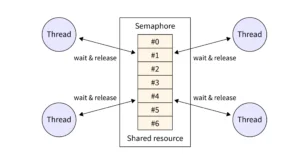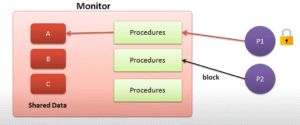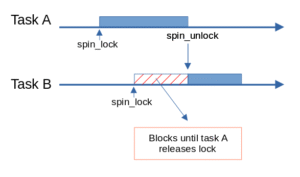Synchronization Mechanisms — Mutex, Semaphores, Monitors, Spinlocks
When multiple processes or threads try to access shared resources such as variables, files, or memory blocks, there’s a risk of inconsistency or corruption if they execute concurrently without coordination. Synchronization mechanisms are used to ensure controlled access, so only one thread accesses the critical section at a time.

Let’s understand the four key synchronization tools used in modern operating systems and concurrent systems: Mutex, Semaphores, Monitors, and Spinlocks.
Mutex (Mutual Exclusion Lock)
Definition: A mutex is a lock mechanism that ensures only one thread can enter its critical section at a time.
How It Works:
- When a thread wants access, it locks the mutex.
- If the mutex is already locked, the thread waits (gets blocked).
- When the thread finishes, it unlocks the mutex, allowing others to proceed.
Key Points:
- Used for short, critical tasks.
- Ideal for multi-threaded applications.
- Mutexes prevent race conditions by enforcing exclusive access.
Limitation:
- Can cause deadlocks if not handled properly (e.g., if a thread locks and never releases).
Semaphores
Definition: A semaphore is a synchronization tool based on a counter that can be used to manage access to multiple instances of a resource.
There are two types:
- Binary Semaphore (acts like a mutex — 0 or 1)
- Counting Semaphore (can have values >1)
How It Works:
- A thread waits (P or down operation) before accessing the resource.
- It signals (V or up operation) after finishing the task.
- The counter determines how many threads can enter simultaneously.
Key Points:
- Useful in producer-consumer and reader-writer problems.
- Can coordinate more complex resource-sharing scenarios than mutexes.
Limitation:
- Misuse can lead to starvation or incorrect signaling.
Monitors
Definition: A monitor is a high-level synchronization construct that combines mutual exclusion and condition variables in an object-like abstraction.
How It Works:
- Only one thread can execute within the monitor at any time.
- Condition variables inside the monitor are used to manage waiting and signaling.
Key Points:
- Monitors are typically supported at the language level (e.g., in Java or Python).
- Easier and safer to use than raw semaphores or locks because of encapsulation.
Limitation:
- Not always available in low-level languages or kernel-level programming.
Spinlocks
Definition: A spinlock is a type of lock where a thread continuously checks (spins) until the lock becomes available.
How It Works:
- Instead of blocking, a thread loops repeatedly checking the lock status.
- Once the lock is free, it acquires it and enters the critical section.
Key Points:
- Best for short critical sections in multi-core systems.
- Avoids the overhead of context switching in blocking locks.
Limitation:
- Consumes CPU cycles while waiting (bad for long waits).
- Not suitable for single-core or low-resource systems.
Summary Table
| Mechanism | Blocking Behavior | Use Case | Suitable For |
|---|---|---|---|
| Mutex | Blocks if locked | Simple mutual exclusion | Threads accessing shared data |
| Semaphore | Blocks if count is 0 | Multiple resource management | Producer-consumer problems |
| Monitor | Language-level control | Structured thread synchronization | Object-oriented concurrency |
| Spinlock | Spins (no block) | Ultra-fast locking in short tasks | Low-overhead, multi-core systems |



